口译笔记练习题(三)的答案
- 格式:doc
- 大小:22.50 KB
- 文档页数:1
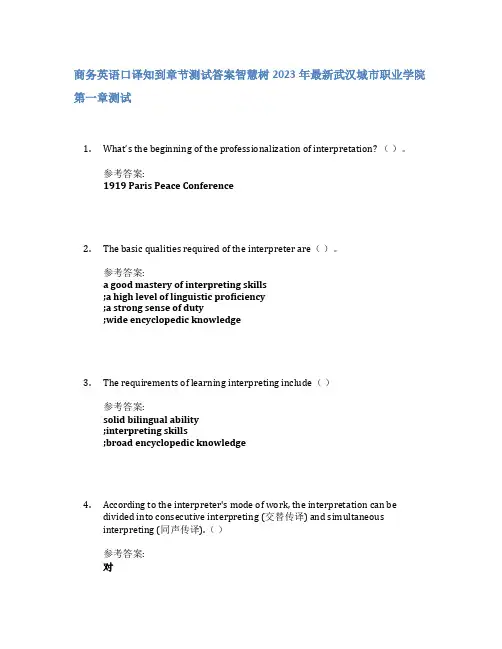
商务英语口译知到章节测试答案智慧树2023年最新武汉城市职业学院第一章测试1.What’s the beginning of the professionalization of interpretation? ()。
参考答案:1919 Paris Peace Conference2.The basic qualities required of the interpreter are()。
参考答案:a good mastery of interpreting skills;a high level of linguistic proficiency;a strong sense of duty;wide encyclopedic knowledge3.The requirements of learning interpreting include()参考答案:solid bilingual ability;interpreting skills;broad encyclopedic knowledge4.According to the interpreter's mode of work, the interpretation can bedivided into consecutive interpreting (交替传译) and simultaneousinterpreting (同声传译).()参考答案:对5.In light of the flow of interpreting, the interpretation can be divided into one-way interpreting (单向口译), and two-way interpreting (双向口译).()参考答案:对第二章测试1.What’s the process of interpretation? ()。
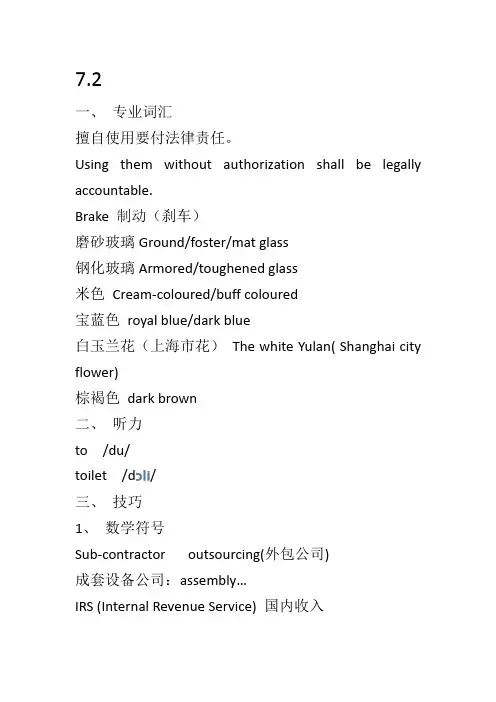
7.2一、专业词汇擅自使用要付法律责任。
Using them without authorization shall be legally accountable.Brake 制动(刹车)磨砂玻璃Ground/foster/mat glass钢化玻璃Armored/toughened glass米色Cream-coloured/buff coloured宝蓝色royal blue/dark blue白玉兰花(上海市花)The white Yulan( Shanghai city flower)棕褐色dark brown二、听力to /du/toilet /dɔli/三、技巧1、数学符号Sub-contractor outsourcing(外包公司)成套设备公司:assembly…IRS (Internal Revenue Service) 国内收入Defense Secretary 外交部长Auto Show=Automobile Industry Exhibition (汽车工业展)2、缩写市政府Municipal People’s Government复婚remarry大力发展generositySS 社会制度CT 文化传统WPD 世界和平发展I’d like to thank sb for kind invitation/thoughtful arrangement/gracious hospitality欢迎某人上台Please join me in welcoming sb onto the stage.We’re very please to have sb with us.3、政治、新闻4、come all the way, 远道而来Conference(文科类的会议)Symposium(理科类的、科技类的研讨会)Seminar (研讨会)Forum (论坛)E.g. … on IT Shanghai 2011 上海2011(国际研讨会)7.9一、口译的Topic应对之策之一:1、Comparison Today I’d like to talk about …2、Opinion Some people thing …3、Other Others believe …4、My opinion …二、口译的Topic应对之策之二:1、Comparison Today I’d like to talk about …2、Achievements3、Problems existing in this field4、Solution三、口译的Topic应对之策之三:1、Comparison Today I’d like to talk about …2、Achievements3、Advantages of doing sth.4、Solution四、Communication1、EQ (Emotion quotient) IQ (intelligence quotient)2、Job vacancy/opportunitiesClear up misunderstandingPromote friendship3、educational background4、healthcare (medical professionals, cities)5、science, technology, pollution6、family, marriage, divorce五、日常知识Tap tops 手提电脑岗前培训:Pre-employment trainingPersonality training 仪表仪容培训进修:Further study儿童医学Pediatrics亲和力winning personality影响shape (customer requirement)“非常好的四金”attractive/competitive benefit/remunerations([ri͵mju:nə'rei∫ən])/package/healthcare system养老保险retirement and pension plan住房公积金public(housing) reserve fund补充公积金fringe benefits补贴subsidyPosition/business travel subsidy 职位津贴、出差补贴Cheese 笑Annuity 年金Your Excellency, the president如果本人不在现场,就用Her majesty, the QueenHis Highness, the Duke… (皇室成员)Your honor, the city mayor of…十月的北京,万木葱茏,金凤送爽。
![口译笔记[1]](https://uimg.taocdn.com/d4bd14c758f5f61fb736665d.webp)
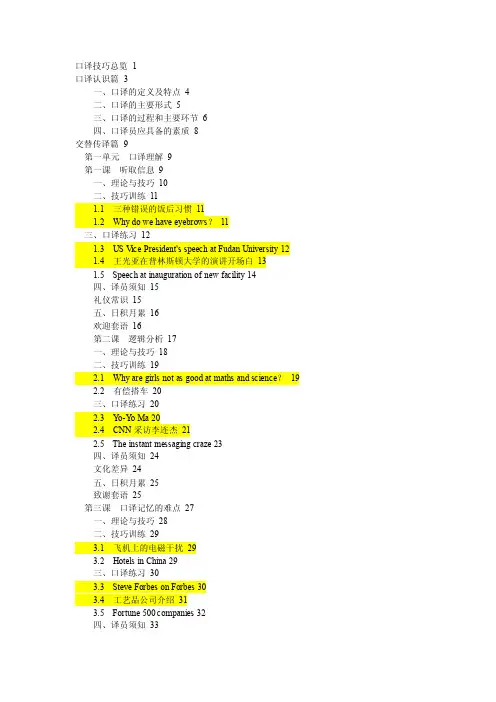
口译技巧总览 1口译认识篇 3一、口译的定义及特点4二、口译的主要形式5三、口译的过程和主要环节6四、口译员应具备的素质8交替传译篇9第一单元口译理解9第一课听取信息9一、理论与技巧10二、技巧训练111.1 三种错误的饭后习惯111.2 Why do we have eyebrows?11三、口译练习121.3 US V ice President's speech at Fudan University 121.4 王光亚在普林斯顿大学的演讲开场白131.5 Speech at inauguration of new facility 14四、译员须知15礼仪常识15五、日积月累16欢迎套语16第二课逻辑分析17一、理论与技巧18二、技巧训练192.1 Why are girls not as good at maths and science?192.2 有偿搭车20三、口译练习202.3 Y o-Y o Ma 202.4 CNN采访李连杰212.5 The instant messaging craze 23四、译员须知24文化差异24五、日积月累25致谢套语25第三课口译记忆的难点27一、理论与技巧28二、技巧训练293.1 飞机上的电磁干扰293.2 Hotels in China 29三、口译练习303.3 Steve Forbes on Forbes 303.4 工艺品公司介绍313.5 Fortune 500 companies 32四、译员须知33宴会口译33五、日积月累34二十四节气34第四课提高口译记忆效率37一、理论与技巧38二、技巧训练394.1 青少年心理健康面临新问题394.2 How you sleep says a lot about what you are 39三、口译练习404.3 Introduction to the University of Westminster 404.4 保持农历新年的核心价值观414.5 On educational exchanges between China and the UK 42四、译员须知43菜肴翻译43五、日积月累44中国各类学历的英文翻译44第五课口译笔记的特点和结构安排47一、理论与技巧48二、技巧训练505.1 随团旅游须知505.2 Tour the White House 51三、口译练习525.3 温总理在世界旅游组织第15届全体大会开幕式上的发言525.4 World Tourism Organization(WTO)535.5 Modernization and preservation 54四、译员须知57导游口译57五、日积月累57中国的世界遗产57第六课口译笔记系统的设计59一、理论与技巧60二、技巧训练646.1 怎样建设世界一流大学646.2 A brief introduction to APEC 65三、口译练习666.3 Eating problems begin in early childhood 666.4 International treaty on tobacco control 676.5 艾滋病的防治68四、译员须知70译前准备(一)70五、日积月累71复合名词切勿望文生义71第七课理解中的应对技巧73一、理论与技巧747.1 Michael Schumacher 757.2 Prepare for the worst 75三、口译练习767.3 Extreme sports 767.4 Rogge's speech at the Athens Olympics 777.5 奥运圣火照北京78四、译员须知79译前准备(二)79五、日积月累80体育报道形容用语80交替传译篇83第二单元口译表达83第八课演讲的技巧(一)口头表述83一、理论与技巧84二、技巧训练858.1 市领导酒会致辞858.2 Seek first to understand 86三、口译练习878.3 温家宝总理谈中国政治体制改革878.4 Managing editor of the Washington Post talks about China 898.5 Commonsense relationship with China:Howard welcomes Hu 90四、译员须知92译员的心理素质92五、日积月累93名家谈演讲93第九课演讲的技巧(二)体态语95一、理论与技巧96二、技巧训练979.1 What makes a good conversation? 979.2 即兴演讲98三、口译练习999.3 中国的计划生育政策是多元化政策999.4 Population aging in developed countries 1009.5 UN Resident Coordinator on China's family and population 101四、译员须知103译员的口才训练103五、日积月累104人口词汇104第十课数字口译的难点105一、理论与技巧106二、技巧训练10710.1 英汉数字转换10710.2 汉英数字转换10810.3 EU-China relationship 10810.4 China-ASEAN relationship 11010.5 外交为民111四、译员须知113口译失误处理113五、日积月累114数字化概括词114第十一课数字的记录与表达117一、理论与技巧118二、技巧训练12011.1 单句口译12011.2 图表口译120三、口译练习12111.3 Dumping and anti-dumping 12111.4 WTO常识问答12211.5 胡锦涛主席在北京《财富》全球论坛开幕式上的讲话125四、译员须知127口译的模糊表达策略127五、日积月累127英文如何表达位次排名?127第十二课信息表达的忠实原则129一、理论与技巧130二、技巧训练13012.1 减肥13012.2 Anything you can say 131三、口译练习13212.3Mobile phone promotion 13212.4纳米技术揭秘13412.5Brig ht future for“.biz” 135四、译员须知137译员在工作中如何与各方合作137五、日积月累138再就业新名词138第十三课语言重组技巧139一、理论与技巧140二、技巧训练14113.1 大发展14113.2Cheap coffee bad for the environment 141三、口译练习14213.3 印度洋海啸14213.4It's time to be green 14413.5对话环保145四、译员须知148译员如何面对各方的反馈148五、日积月累149中英文对出天下第一联149第十四课口译表达中的应对技巧151一、理论与技巧152二、技巧训练15314.1 British investment in Shanghai 15314.2 第四届中国国际高新技术成果交易会开幕词154三、口译练习15514.3 商务部副部长马秀红在振兴东北老工业基地论坛上的致辞15514.4 Opening Speech at the Western China International Economic & Trade Fair 15614.5 Speech at International Seminar on HRD in Western China 158四、译员须知160口译员平时积累的重要性160五、日积月累161全球十大最难翻译的单词161交替传译篇163第三单元话语分析与跨文化交际意识163第十五课话语分析与口译理解163一、理论与技巧164二、技巧训练16515.1 Changes in East Asia and reform of the IMF 16515.2 China's development has not been achieved at the expense of others 165三、口译练习16615.3 中国外贸实现开门红16615.4 The WTO does not destroy jobs or widen the gap between rich and poor 16715.5 Trade and environment:striking a balance 169四、译员须知171商务口译的形式171五、日积月累172绿箱·黄箱·蓝箱172第十六课话语分析与口译表达175一、理论与技巧176二、技巧训练17716.1 The people factor comes first 17716.2 关于人才问题178三、口译练习17816.3 Negotiations on a joint venture 17816.4 Hazard Analysis and Critical Control Point(HACCP)system 18116.5 中国吸引外商投资的政策导向183四、译员须知184商务口译中应注意的事项184五、日积月累185有趣的经济学名词185第十七课译员的跨文化交际意识和能力187一、理论与技巧188二、技巧训练18917.1 The new generation of China specialists 18917.2 The world's culture types 189三、口译练习19117.3 厦门旅游业招商项目19117.4 SSS Corrosion Protection Company seeks cooperation in China 19217.5 A brief introduction to AgustaWestland 194四、译员须知195商务谈判中译员的立场195五、日积月累196按196第十八课译员语言能力的提高199一、理论与技巧200二、技巧训练20118.1 Impressionists 20118.2 The origin ofhip-hop 202三、口译练习20318.3 Samsung Electronics and mobile phones 20318.4 Dell's business operation in Asia Pacific 20418.5 鄂尔多斯集团简介206四、译员须知207实地参观和境外访问的商务口译207五、日积月累207歇后语207第十九课语言外知识的习得209一、理论与技巧210二、技巧训练21019.1 The reality ot reefs' 21119.2 Solar power 211三、口译练习21219.3 What is law?21219.4 法庭上的案情询问21319.5 The path of the law 215四、译员须知217法庭口译注意事项217五、日积月累217“审判”译法采撷217第二十课视译的运用和技巧219一、理论与技巧220二、技巧训练22020.1 Don't be too optimistic 22120.2 东亚区域经济统合221三、口译练习22220.3 China should not appreciate its currency now 22220.4 加强中欧在经贸和金融领域的合作22320.5 American multinationals have kept most of their jobs at home 225四、译员须知226富含文化内涵词语的口译226五、日积月累227中医术语翻译哭笑不得文化理解差异推迟中医国际化227第二十一课译员职业道德准则229一、理论与技巧230二、口译练习23121.1 Hackers attack Macintosh OS X operating system 23121.2 实施探月工程对我国科技和经济发展的意义23221.3 Embryonic stem-cell research 233三、译员须知235从业指导235四、日积月累236翻译风波236同声传译篇239第二十二课多任务训练239一、理论与技巧240二、技巧训练24122.1 My history 24122.2 文化奥运24222.3 My opinion 24222.4 蒙古族习俗24322.5 The difficulties that SMEs face in doing business 24422.6 IT时代的拇指族24522.7 Singapore needs a road safety culture 24622.8 伊战后局势恶化根源何在248三、译员须知249同声传译职业简介249四、日积月累249引经据典249第二十三课顺句驱动251一、理论与技巧252二、技巧训练253三、口译练习25423.1 Introductory remarks by the President of the University of Illinois 25423.2 “中欧经济论坛2004”开幕式上的讲话节选25623.3 My life in China 258四、译员须知259同传译员的基本素质259五、日积月累260妙用一词,事半功倍260第二十四课预测和信息储存263一、理论与技巧264二、技巧训练265三、口译练习26624.1 Cyber Café 26624.2 校庆致辞26724.3 President Bush welcomes Premier of China to the White House 268四、译员须知270同声传译的标准270五、日积月累270四字格排比270第二十五课有稿同传273一、理论与技巧274二、技巧训练27525.1 中国商协会在推动经济发展中的作用27525.2 Speech by Niall FitzGerakd,KBE Chairman Unilever plc,at a WTO public symposium 277三、口译练习27925.3 钱其琛在“亚太2020远景规划高级别小组讨论会”上的发言摘要27925.4 Speech by Bill Gates following the announcement of the ruling from the Court of Appeals 281四、译员须知283同声传译的译前准备283五、日积月累284诗词名句284第二十六课幻灯片同传285一、理论与技巧286二、技巧训练28726.1 Communication models 28726.2 “环境之星”指南288三、口译练习29026.3 提升中小企业竞争力29026.4 An introduction of the EU Asia-Link Programme 293四、译员须知297同传译员与各方的合作297五、日积月累298中国特色形象描述词298第二十七课同传中的应对技巧301一、理论与技巧302二、技巧训练30327.1 Speech by Sir John Bond at the China Development Forum 30327.2 “大连·东北亚重要国际航运中心论坛”发言304三、口译练习30627.3 加强国际合作促进共同发展30627.4 Carly Fiorina's remarks at Tsinghua University 308四、译员须知311同传中出错怎么办?311五、日积月累312中国历史年表312。
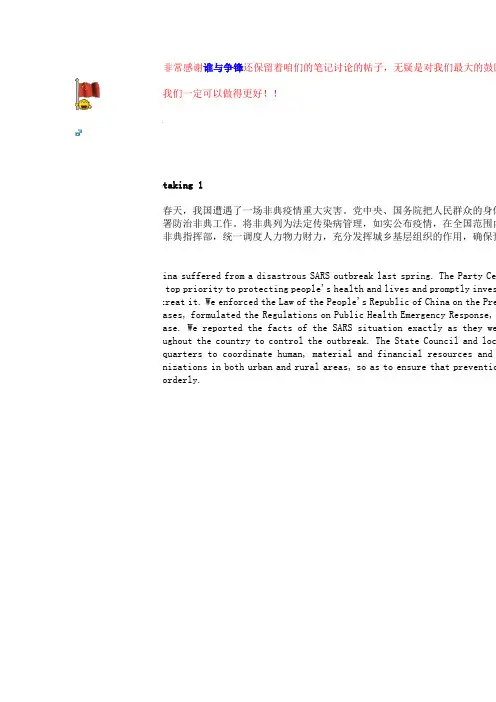
非常感谢谁与争锋还保留着咱们的笔记讨论的帖子,无疑是对我们最大的鼓励相信我们一定可以做得更好!!ricotetaking 1去年春天,我国遭遇了一场非典疫情重大灾害。
党中央、国务院把人民群众的身体和部署防治非典工作。
将非典列为法定传染病管理,如实公布疫情,在全国范围内防治非典指挥部,统一调度人力物力财力,充分发挥城乡基层组织的作用,确保预.China suffered from a disastrous SARS outbreak last spring. The Party Ce ave top priority to protecting people's health and lives and promptly inves nd treat it. We enforced the Law of the People's Republic of China on the Pre iseases, formulated the Regulations on Public Health Emergency Response, isease. We reported the facts of the SARS situation exactly as they we hroughout the country to control the outbreak. The State Council and loc eadquarters to coordinate human, material and financial resources and rganizations in both urban and rural areas, so as to ensure that preventio nd orderly.分析:要说明的一点是这个版本完全是我自己的版本,最终出来的结果也绝对和英文版的不一样。
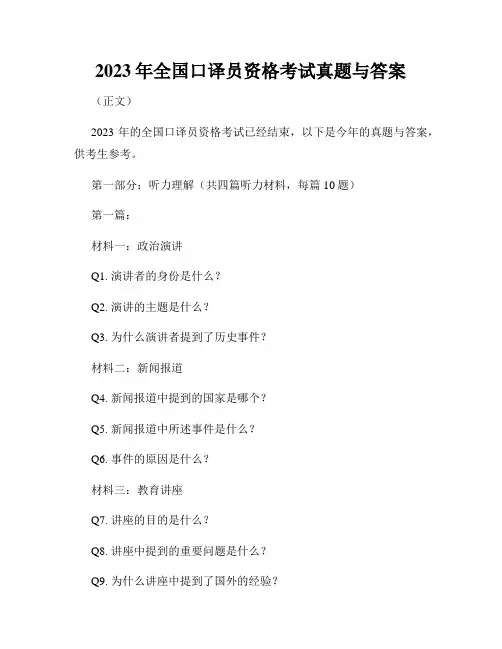
2023年全国口译员资格考试真题与答案(正文)2023年的全国口译员资格考试已经结束,以下是今年的真题与答案,供考生参考。
第一部分:听力理解(共四篇听力材料,每篇10题)第一篇:材料一:政治演讲Q1. 演讲者的身份是什么?Q2. 演讲的主题是什么?Q3. 为什么演讲者提到了历史事件?材料二:新闻报道Q4. 新闻报道中提到的国家是哪个?Q5. 新闻报道中所述事件是什么?Q6. 事件的原因是什么?材料三:教育讲座Q7. 讲座的目的是什么?Q8. 讲座中提到的重要问题是什么?Q9. 为什么讲座中提到了国外的经验?材料四:旅游广告Q10. 广告中提到的旅游目的地是哪里?Q11. 广告中提到的旅游活动是什么?Q12. 为什么这个目的地适合旅游者?第二部分:阅读理解(共三篇阅读材料,每篇15题)阅读材料一:科技文章Q13. 文章主要讨论的是什么科技?Q14. 这项科技在哪个领域有潜在的应用?Q15. 文章中提到的优势是什么?阅读材料二:商业报告Q16. 这项报告是为了解决什么问题而进行的?Q17. 报告中列举的企业案例是在哪个行业?Q18. 为什么这些企业需要实施改变?阅读材料三:文化研究Q19. 这篇研究报告主要探讨的是哪个文化现象?Q20. 文章中提到的原因是什么?Q21. 研究的结果如何?第三部分:口译表达(共两个任务,每个任务5题)任务一:逐句口译请根据提供的英文句子逐句进行口译,语速适当,重点表达清晰。
任务二:长篇口译请根据提供的长篇英文短文进行口译,重点把握短文的主旨和要点。
第四部分:口译笔记(共两个任务,每个任务5题)任务一:根据听到的短语或句子写下意思。
(考生需根据听到的内容尽量准确地写下对应的中文意思)任务二:边听边翻译句子。
(考生需根据听到的英文句子边听边翻译成中文)答案解析:这部分根据具体真题来回答,可以提供详细的解析和参考答案,以帮助考生对于每个问题有更好的理解。
总结:在2023年的全国口译员资格考试中,听力理解部分、阅读理解部分和口译表达部分都是相应考生表现语言理解、表达和口译能力的重要环节。
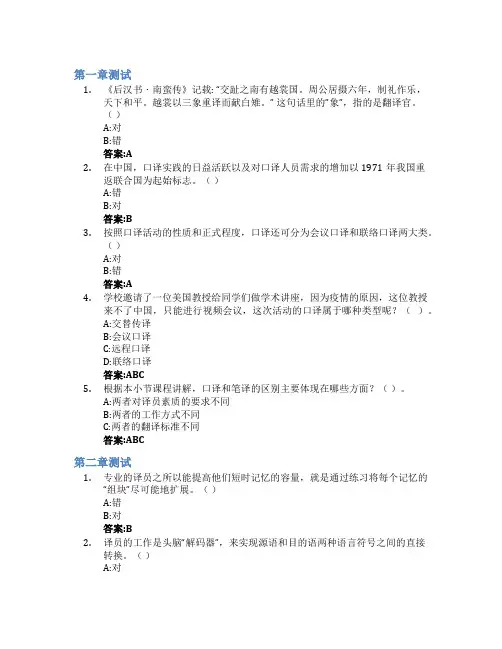
第一章测试1.《后汉书・南蛮传》记载: “交趾之南有越裳国。
周公居摄六年,制礼作乐,天下和平。
越裳以三象重译而献白雉。
” 这句话里的”象”,指的是翻译官。
()A:对B:错答案:A2.在中国,口译实践的日益活跃以及对口译人员需求的增加以1971年我国重返联合国为起始标志。
()A:错B:对答案:B3.按照口译活动的性质和正式程度,口译还可分为会议口译和联络口译两大类。
()A:对B:错答案:A4.学校邀请了一位美国教授给同学们做学术讲座,因为疫情的原因,这位教授来不了中国,只能进行视频会议,这次活动的口译属于哪种类型呢?()。
A:交替传译B:会议口译C:远程口译D:联络口译答案:ABC5.根据本小节课程讲解,口译和笔译的区别主要体现在哪些方面?()。
A:两者对译员素质的要求不同B:两者的工作方式不同C:两者的翻译标准不同答案:ABC第二章测试1.专业的译员之所以能提高他们短时记忆的容量,就是通过练习将每个记忆的“组块”尽可能地扩展。
()A:错B:对答案:B2.译员的工作是头脑“解码器”,来实现源语和目的语两种语言符号之间的直接转换。
()A:对B:错答案:B3.数字口译是难点,是因为英、汉两种语言在数字的表达上存在较大的差别,最主要表现在它们有不同的分段方式。
()A:对B:错答案:A4.学习口译技巧应遵循先单项再,先简单再,反复操练,以形成习惯。
()A:多项,复杂B:多项,综合C:复杂,综合D:综合,复杂答案:D5.口译的过程可以分为如下哪三个主要环节?A:信息的记忆B:源语的理解C:目的语理解D:目的语表达答案:ABD第三章测试1.汉语意合特征明显,显性的语法比重较大,很少使用隐形的连接手段和连接词。
()A:错B:对答案:A2.()是介于语言项目之间的一种关系,即用少量语言形式取代上文中的某些成分。
A:省略B:替代C:照应答案:B3.词汇衔接手段主要有哪几种()A:反义B:同义C:同现D:重复E:上下义答案:ABCDE4.语法衔接手段主要有哪几种()A:照应B:连接C:替代D:省略答案:ABCD5.受时限和短时记忆容量的限制,口译时要本着顺译的原则及时断句。
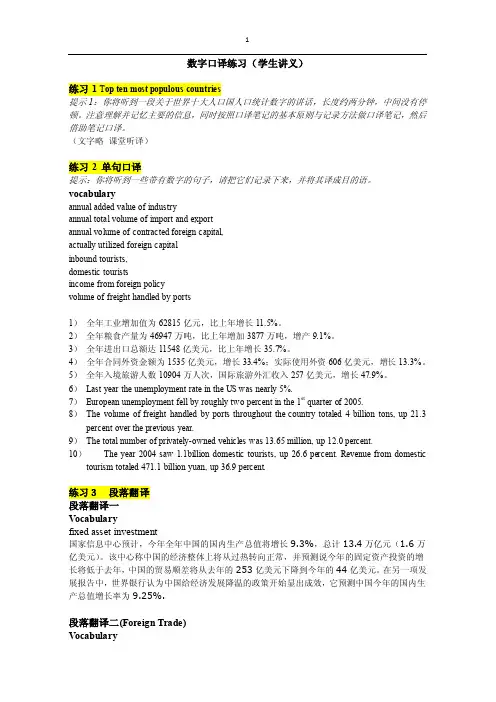
数字口译练习(学生讲义)练习1 T op ten most populous countries提示1:你将听到一段关于世界十大人口国人口统计数字的讲话,长度约两分钟,中间没有停顿。
注意理解并记忆主要的信息,同时按照口译笔记的基本原则与记录方法做口译笔记,然后借助笔记口译。
(文字略课堂听译)练习2 单句口译提示:你将听到一些带有数字的句子,请把它们记录下来,并将其译成目的语。
vocabularyannual added value of industryannual total volume of import and exportannual volume of contracted foreign capital,actually utilized foreign capitalinbound tourists,domestic touristsincome from foreign policyvolume of freight handled by ports1)全年工业增加值为62815亿元,比上年增长11.5%。
2)全年粮食产量为46947万吨,比上年增加3877万吨,增产9.1%。
3)全年进出口总额达11548亿美元,比上年增长35.7%。
4)全年合同外资金额为1535亿美元,增长33.4%;实际使用外资606亿美元,增长13.3%。
5)全年入境旅游人数10904万人次,国际旅游外汇收入257亿美元,增长47.9%。
6)Last year the unemployment rate in the US was nearly 5%.7)European unemployment fell by roughly two percent in the 1st quarter of 2005.8)The volume of freight handled by ports throughout the country totaled 4 billion tons, up 21.3 percent over the previous year.9)The total number of privately-owned vehicles was 13.65 million, up 12.0 percent.10)The year 2004 saw 1.1billion domestic tourists, up 26.6 percent. Revenue from domestic tourism totaled 471.1 billion yuan, up 36.9 percent.练习3段落翻译段落翻译一Vocabularyfixed asset investment国家信息中心预计,今年全年中国的国内生产总值将增长9.3%,总计13.4万亿元(1.6万亿美元)。
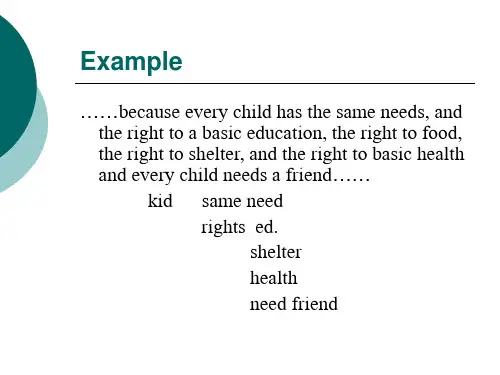
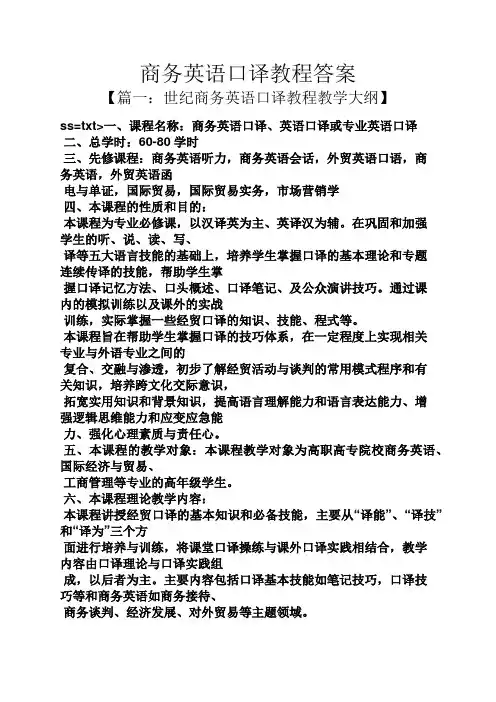
商务英语口译教程答案【篇一:世纪商务英语口译教程教学大纲】ss=txt>一、课程名称:商务英语口译、英语口译或专业英语口译二、总学时:60-80学时三、先修课程:商务英语听力,商务英语会话,外贸英语口语,商务英语,外贸英语函电与单证,国际贸易,国际贸易实务,市场营销学四、本课程的性质和目的:本课程为专业必修课,以汉译英为主、英译汉为辅。
在巩固和加强学生的听、说、读、写、译等五大语言技能的基础上,培养学生掌握口译的基本理论和专题连续传译的技能,帮助学生掌握口译记忆方法、口头概述、口译笔记、及公众演讲技巧。
通过课内的模拟训练以及课外的实战训练,实际掌握一些经贸口译的知识、技能、程式等。
本课程旨在帮助学生掌握口译的技巧体系,在一定程度上实现相关专业与外语专业之间的复合、交融与渗透,初步了解经贸活动与谈判的常用模式程序和有关知识,培养跨文化交际意识,拓宽实用知识和背景知识,提高语言理解能力和语言表达能力、增强逻辑思维能力和应变应急能力、强化心理素质与责任心。
五、本课程的教学对象:本课程教学对象为高职高专院校商务英语、国际经济与贸易、工商管理等专业的高年级学生。
六、本课程理论教学内容:本课程讲授经贸口译的基本知识和必备技能,主要从“译能”、“译技”和“译为”三个方面进行培养与训练,将课堂口译操练与课外口译实践相结合,教学内容由口译理论与口译实践组成,以后者为主。
主要内容包括口译基本技能如笔记技巧,口译技巧等和商务英语如商务接待、商务谈判、经济发展、对外贸易等主题领域。
教学重难点:笔记技巧与实践,口译技巧与实践,记忆力训练和视译训练,商务英语表达各章节教学内容及教学要求如下:模块选材训练内容第一模块训练选材内容为商务场合与活动第一课接待、入住酒店、参观记忆力训练第二课洽谈、购物、宴会对话第三课旅游产品介绍送机第二模块训练选材内容为国际贸易实务第四课询盘、报盘、还盘记忆力训练第五课支付、保险、运输对话、段落第六课包装、索赔、代理笔记技巧讲解及训练、数字训练第三模块训练选材内容为大商务第七课经济发展与改革段落、文章第八课对外贸易视译第九课国际经济与贸易组织介绍翻译技巧及训练第四模块训练选材内容为综合性第十课同传训练(介绍性质)同传技巧及训练学时分配表:七、本课程考核方式本课程为非统一考试科目。
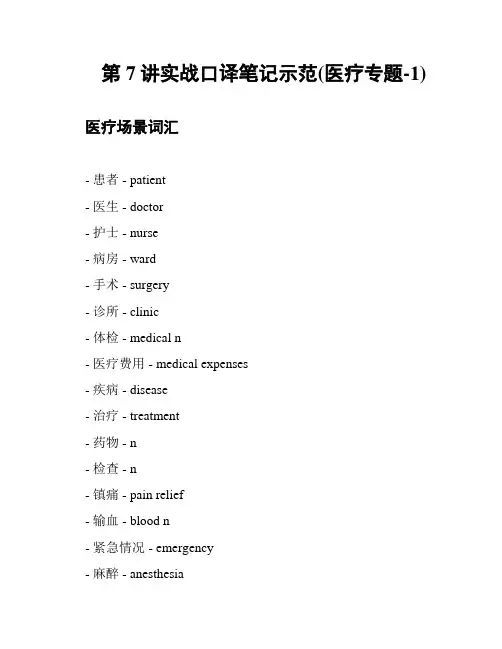
第7讲实战口译笔记示范(医疗专题-1)医疗场景词汇- 患者 - patient- 医生 - doctor- 护士 - nurse- 病房 - ward- 手术 - surgery- 诊所 - clinic- 体检 - medical n- 医疗费用 - medical expenses- 疾病 - disease- 治疗 - treatment- 药物 - n- 检查 - n- 镇痛 - pain relief- 输血 - blood n- 紧急情况 - emergency- 麻醉 - anesthesia常见病例对话对话一医生:您好,有什么不舒服的症状吗?患者:我最近老是头疼,而且晚上还会咳嗽。
医生:好的,请您稍等一下,我会给您做一次全面的身体检查。
对话二医生:您好,请问您是怎么受伤的?患者:我在走路的时候不小心摔了一跤,现在膝盖很疼。
医生:好的,请您先躺下,我会给您进行一次X光检查。
医生建议与患者回应医生:根据检查结果,您的情况并不严重,只是轻微扭伤,请注意休息,多做热敷。
患者:好的,谢谢医生。
医生:同时,我也给您开了一些消炎药和止痛药,请按照剂量服用。
患者:好的,我会按时服药的。
介绍医疗服务医生:我们诊所提供多种医疗服务,包括一般检查、手术和紧急情况处理等。
患者:那如果有手术需要,需要提前预约吗?医生:是的,手术通常需要提前预约,您可以提前到诊所咨询并安排手术时间。
医疗费用与结算方式医生:关于医疗费用,我们通常是在治疗结束后结算,请您带好社保卡和身份证。
患者:好的,我会提前准备好。
医生:如果有需要,我们也提供分期付款的方式进行结算。
患者:明白了,谢谢医生。
实战口译笔记口译笔记:眼看笔记即可口出译文1非大片文字2经过消化的内容(半成品)笔记要点1少写多划(少书写汉字,多划线条以代之)2少些多意(一个字顶一个甚至几个)3少线多指(通用一组线条\标记)4少横多竖(采取从上到下的阶梯结构)5快速书写(发展自己的汉字快速书写系统)6明确结束带活页圈的笔记本,按压笔口译四大要领:别停下(听懂/记下什么译什么,不能卡住),别露陷(不要暴露没听懂,没记下,硬着头皮译),别着急(把握自己的说话节奏,把握译员特有的控制权),别太久(讲话人讲完之后两秒钟之内翻译)三步法:问(讲话人,对方议员,在场其他人),补(没问清楚,根据上下文和自己的理解,补齐原话的句子或意思),扔(没听懂的地方干脆不译)去繁就简文化差异:thank you for...重复表达:重复明确动作的始发者重复的两大类型:1后面两个字说的意思和前面两个字差不多2强调语气的词,其实并没有增加新的意思刻苦勤奋-diligent兢兢业业-dedicated多才多艺-talented不断扩大-expanding更新,更高的要求-higher demand无数仁人志士苦苦探索救国救民的道路numerous good and ambitious people tried again and again and very hard too,to find a way to save the country and the nationwe searched hard for a way to save the nation坚决,彻底,全面的改革firm,thorough and comprehensive improvementthorough improvement多余字词中文一句话的最后一个词,似乎是在总结概括前面已经描述过的情况。
译成英文时,最后这个总结词经常可以扔掉复杂词句:抛开原文,看清意思,白话说出权衡英文习惯口译平衡尺度:中文习惯,英文习惯把握平衡的原则:a目标听众/读者b原文/原讲话人预期达到的效果c你作为翻译的定位d 交给你的翻译任务e本次笔译或者口译任务的性质(客户目的和译者定位)使用第一人称a谈话内容和场合越正式,越需要讲话人的第一人称“我”b如果译员同时服务于多名讲话人,就可能不得不用讲话人的名字,职称,或称号来区分那段话是谁说的c如果两个人热烈交谈,说话不长,你一句,我一语,也只能用第一人称d在把握不准的时候,也应该用第一人称“我们”以某公司或组织机构的身份发言借用同传技能:分脑技能:兼顾听讲,理解,(笔记)翻译,表达断句:按顺序,分段处理三字诀:顺,补,加顺着译,补语气,加解释two ballons were floating across the desert.One balloon said to the other:"Look out for the cactusssssssss!"三方两面交流与讲话人交流,与听众交流,a尊重b注意力c信心d反馈声音和口才使用不同的声音口才:大众之前的表演;说三法“张口说三”如何处理讲稿:视译,熟悉全文,查阅关键生词,商讨额外收费口译人际关系:双方译员(分工),己方(雇主,客户首要人物,客户决策人物,客户其他人物),对方(对方首要人物,对方决策人物,对方其他人物)接受口译任务a接受任务任务性质:翻译类型,客户,场合,听众,主题内容或者行业,意图,有无稿件,是否有必要与客户见面交代,有问题与谁联系,向谁报告相关事项:时间,地点,人,通行证,报酬(货币:发票,支票,转账,币种),旅行和饭店预订,有无接待,最佳交通方法,三餐b事前准备准时,提前是到十五分钟,装备c当天发挥d任务后的任务自我评估,自我改进职业技能组合:沟通联络,桌前调研,行程安排,紧跟主要讲话人,临场以及意外情况的应付如何准备简历自由职业口译口译interpreting:译员在听取源语后source language,通过口头表达的方式以目标语target language向听众传达讲话人的意思,在语言上无法互通的异语双方或多方之间通过译员的传译能够进行交流沟通。
通用口译教程答案【篇一:口译经验】试篇笔试分section1、2两卷,都有听力、阅读、翻译三部分,但这三部分的难度很有挑战性,section 1的听力有spot dictation和听力选择题(这个不难),spot dictation只听一遍,每个空还要填至少三个单词,有时还是一整句话,这部分应该至少要拿到70%分数,每次做完后自己算分,一次一次加强,训练到最后这部分一定是你最强的,而且听写是开考第一部分,答的好也会给自己一个良好的心里暗示,越做越顺。
这部分写字速度一定要快,当然,笔记符号更重要。
有一点要注意,笔试与口试的笔记符号应该有一些不同,笔试dictation应该是主要复原单词,而口试时主要是复原意义。
这一点后面详述。
平时训练时一定要发明自己的符号,这要为口试打好基础,老师说,能过口试的人都有一个共同点,笔记清晰逻辑强,快速中英转换。
我自己就总结了许多单词的缩写,还在网上借鉴了很多,加起来也有几百个了,想要的童鞋可以跟我要啊。
s1的听力选择题相比就有点送分了,是我们从小学就做到大学的题型,其中有几道新闻听力要特别提醒下,倒金字塔结构第一句话是解题良方。
section1阅读文章都是直接选自英美刊物,如time、economist、guardian,比较不容易看懂),个人感觉是笔试最难的了。
平时训练时正确率还可以,我考试时错了一半,最重要的是这部分一共也就有35-40分左右的答题时间,要搞定4篇1000字左右的外刊原文,每篇5个题也就7分半钟,看懂都要耗很多时间,要做对真的很难。
不过要啃下这块硬骨头也不难的,我在复习的时候买了一本星火英语的专八阅读,因为那里面的题也是从外刊选的,还有翻译,感觉不错。
好像是一百篇吧,每天就按照高口时间要求做4篇。
积累了大量的词汇和英语原汁原味表达法,比单背单词收获大多啦,中口可以买本专四的阅读看看,总之,这部分不要太在意,我难人亦难,时间实在不够就蒙答案吧。
一、课程性质和设置目的口译课程是高等教育自学考试英语专业高级阶段(本科)的英语技能训练课程,属必考课程。
它旨在培养学生动用已掌握的英语语文知识和听、说等基本技能,进行英汉/汉英双向口译的能力;使学生能胜任生活接待、导游、一般性会议和业务洽谈等的口译任务。
二、考核内容与考核目标口译考试分为汉英和英汉口译两部分,形式为接续翻译,考究学生综合动用演说、记忆、笔记、解释、数字翻译、跨文化交流等口译技巧的能力。
要求老先生能正确理解并即时口头翻译所听到的语速为每分钟160-200字/词的讲话。
三、有关说明与实施要求1.考试形式本课程考试采取面试形式,考生听录音或主考老师的讲话,在停顿处开始口译,可带纸笔做笔记,录音和讲话只能听一次,不予重复。
考试时间约为10分钟,汉英和英汉口译各占大约5分钟。
2.必读书目《汉译英口译教程(修订本)》吴冰主编者外语教学与研究出版社1995年《英语高级口译资格证书考试口译教程》梅德明编上海外语教育出版社1996年3.考试样题及参考答案题样一A 汉译英朋友们,欢迎大学到北京来,从今天开始由我担任大家的陪同,我将尽力使朋友们在北京过得愉快。
// 我想朋友们都知道,北京是座有三千年历史的古城。
早在公元前十一世纪,北京就是燕国的国都,因此北京有燕京之称。
// 在以后的几千年里,北京又成为金、元、明、清各朝的国都。
北京是中国的六大古都之一,其他五个是西安、南京、洛阳、开封和杭州。
这些城市中有几个大家这次也要去。
// 北京市总面积16,800平方公里,人口1,000多万。
城区在解放时是190平方公里,今天已扩大到750平方公里。
// 北京是座既古老又年轻的城市,有许多名胜古迹。
从故宫、天坛和颐和园,你们可以看到北京保留了许多昔日的风采。
北京也有许多新建筑,包括很多摩天大厦和立体交叉桥,这些又使北京具有现代化都市的风貌。
参考答案Friends, welcome to Beijing ! From today on I’ll act as your guide, and I’ll do my best to make your stay a pleasant one. // I believe you all know that Beijing is an ancient city with a history of 3,000 years. As early as the 11th century, B.C., it was the capital of the kingdom of Yan; that’s why Beijing is also known as Yanjing. // In the few thousand yearsafterwards, Beijing again served as the capital for the Jin, Yuan, Ming, and Qing dynasties.Beijing is one of China’s six ancient capitals; the other five are Xi’an, Nanjing, Luoyang, Kaifeng, and Hangzhou. Some of these cites you will also be visiting during your stay in China. // with an area of 16,800 sq. Km, It has a population of over ten million .The city proper in 1949(when the people’s Republic was founded) was 190 sq.km, but today it has expanded to 750 sq.km. // Beijing is a city both old and young, with many places of historic interest and scenic beauty. From the forbidden City, the Temple of Heaven, and Summer Palace, you can see that Beijing has retained a lot of the color of old Chinese life. But there are also a great number of new constructions in Beijing , including many skyscrapers, cloverleaf intersections and flyovers. These have given beijing the look of a modern metropolis.B英译汉Question : Mr. President, I’m sure millions of Chinese people are watching this program now . Iwonder if you would like to say a few words to them first.//Answer: Well, I do have an opening statement. But first let me thank you for this unique opportunity. It’s a great honor for me to be the first American president to speak to the Chinese people in a live broadcast. // And I feel as if I were talking to old friends, who, while teen years ageo, Barbara and Icame to your beautiful land when I was , as you said , Chief of the United States Liaison Office , And for us , returning to Beijing is a homecoming.// Our work here was a source of great personal satisfaction, a happy challenging time in our lives. And we actually went to church here, and indeed our daughter was baptized in our faith here. And we rode bicycles down the hutungs of Beijing, and came to have a general feeling of affection for the Chinese people.参考答案问:总统先生,我敢肯定此时此刻有亿万中国人正在观看这个节目。
英语口译笔记法实战指导Ⅵ.笔记法汉译英练习1.25年间.中国创造的巨大财富,不仅使13亿中国人基本解决了温饱,基本实现了小康,而且为世界发展做出了贡献。
The tremendous wealth created by、China in the past quarter of a century has not only enabled our 1.3 billion countrymen to meet their basic needs for food,clothing and shelter and basically realize a modestly comfortable standard of living but also contributed to world development.2.中国信息产业既是信息化建设的基础,同时也是信息化的重要组成部分。
The information industry in China forms the basis for information .It is also part of the process.3.13亿人口的中国保持稳定和加快发展,对促进亚太地区和世界的稳定与发展,具有极其重要的意义。
China is a country with 1.3billion people. It stability and rapid development are of vital importance to the stability and development in Asia-Pacific Region and the world at large.4.只要双方有诚意,这类问题完全可以通过平等协商和扩大合作来加以妥善解决。
So long as the two sides act in good faith ,such problems can be properly resolved through consultations on equal terms and the expansion of bilateral cooperation .5.所以有些地方官员确实不重视农业,确实是口号农业。
会议口译期末考试题及答案一、听力理解与笔记(共30分)1. 听录音材料,完成以下笔记任务(每题5分,共10分):- 记录会议的主要议题。
- 记录发言人的姓名和其主要观点。
2. 根据所记录的笔记,回答以下问题(每题5分,共10分):- 会议中有哪些关键决策?- 会议中提到的主要问题及其解决方案是什么?3. 根据所记录的笔记,总结会议的主要内容。
(10分)二、同声传译模拟(共40分)1. 听录音材料,进行同声传译,将发言人的发言内容翻译成目标语言。
(20分)2. 根据同声传译的内容,回答以下问题(每题5分,共10分):- 发言人提出了哪些建议?- 发言人对当前情况的评估是什么?3. 请对同声传译的质量进行评价,包括准确性、流畅性和完整性。
(10分)三、交替传译模拟(共30分)1. 听录音材料,进行交替传译,将发言人的发言内容翻译成目标语言。
(15分)2. 根据交替传译的内容,回答以下问题(每题5分,共10分):- 发言人对项目进展的描述是什么?- 发言人提出的下一步行动计划是什么?3. 请对交替传译的质量进行评价,包括准确性、流畅性和适应性。
(5分)会议口译期末考试答案一、听力理解与笔记1. 笔记任务答案示例:- 主要议题:讨论新项目的市场推广策略。
- 发言人及观点:张三认为应该加大社交媒体的广告投入,李四则建议增加线下活动。
2. 问题答案示例:- 关键决策:决定增加10%的预算用于市场推广。
- 主要问题及解决方案:产品知名度不高,解决方案是增加广告投放和合作媒体。
3. 会议主要内容总结:本次会议主要围绕新项目的市场推广策略展开讨论,与会者提出了多种推广方案,最终决定增加预算并采取线上线下相结合的推广方式。
二、同声传译模拟1. 同声传译答案示例:[此处应为一段同声传译的录音或文本,由于是文本形式,无法提供音频,故省略。
]2. 问题答案示例:- 建议:增加社交媒体广告投放,与行业KOL合作。
- 当前情况评估:产品在市场上的知名度有待提高,需要通过有效的推广策略来提升。